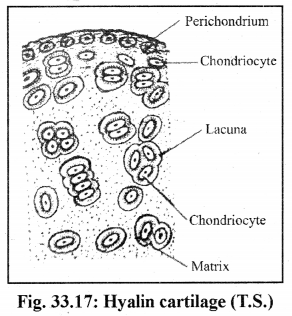Rajasthan Board RBSE Class 11 Biology Chapter 33 Animal Tissue
RBSE Class 11 Biology Chapter 33 Multiple Choice Objective Questions
Question 1.
Blood is a
a. Epithelial tissue
b. Connective tissue
c. Nervous tissue
d. Not a tissue
Question 2.
The muscle which never under go muscle fatigue
a. Striated muscle
b. Unstriped muscle
c. Cardiac muscle
d. None of the above
Question 3.
The gaps (constrictions) in the axon are called as
a. Nodes of Ranvier
b. Nodes of Schwann
c. Dendron
d. Synapse
Question 4.
Unipolar neurons are found in
a. In whole body
b. Brain
c. Spinal cord
d. Retina
Question 5.
Medullated nerve has covering of
a. Proteins
b. Fat
c. Carbohydrate
d. Epitheluim
Answers :
1. b
2. c
3. a
4. d
5. b
RBSE Class 11 Biology Chapter 33 Very Short Answer Questions
Question 1.
What is called the functional junction between two neuron?
Answer :
Synapse
Question 2.
Give example of liquid connective tissue.
Answer :
Blood & Lymph
Question 3.
Name the granules found in the cyton of neuron.
Answer :
Nissl’s bodies
Question 4.
What is the main role of globulin proteins in the blood?
Answer :
Formation of antibodies
Question 5.
Which cells secrete the protein essential for growth of cartilage?
Answer :
Chondrioblasts
Question 6.
Write the name of structural and functional unit of nervous system?
Answer :
Neuron
Question 7.
Where the Schwann cells are found?
Answer :
Neurolemma of axon
Question 8.
Give example of striated involuntary muscle.
Answer :
Cardiac muscle
Question 9.
“What is the amount of hemoglobin in 100 ml of blood of a healthy person?
Answer :
12 to 16 gm %
Question 10.
Write the names of proteins found in striated muscle
Answer :
Actin & Myosin
Question 11.
Matrix of cartilage is made up of which protein?
Answer :
Answer :
Chondrin protein
Question 12.
Give the life span of RBC.
Answer :
50-120 days
Question 13.
Name the WBC that secrete heparin.
Answer :
Basophils
Question 14.
Name the blood cells that participate in blood clotting.
Answer :
Platelets
Question 15.
Which tissue has intercalated discs.
Answer :
Cardiac Muscle tissue
Question 16.
Name the cells of the nervous system.
Answer :
Neurons & Glial cells
RBSE Class 11 Biology Chapter 33 Short Answer Questions
Question 1.
Differentiate Bone & Cartilage.
Answer :
| Bone | Cartilage |
| (i) Cell are osteoblasts & Osteocytes | (i) Cells are chondrioblasts & Chondriocytes |
| (ii) Ossein Protein | (ii) Chondrin Protein |
| (iii) Havesrian’s Systems present | (iii) Absent |
Question 2.
Which are called as voluntary muscles & why?
Answer :
Skeletal muscles are called as voluntary muscles. They can be controlled by will.
Question 3.
What will be the effect on the body when the formation of lymph corpuscles stops?
Answer :
Body immunity will reduced / lost.
Question 4.
What is Haversian’s system?
Answer :
Arrangement of lamillae in the Mammalian bones.
Question 5.
Explain the structure of cardiac muscles.
Answer :
They are special muscle which are found only in the heart. The muscle fiber of cardiac muscle is elongated, thread like and branched. They have light and dark bands but they are involuntary in function. They have special intercalated discs. They never under go muscle fatigue. They have hemoglobin & always perform aerobic respiration.
Question 6.
Explain the types of neurons on the basis of number of nerve fibers.
Answer :
Types of neurons :
On the basis of number of axon & dendron, the neurons are of three types-
(a) Unipolar neurons – Presence of only one axon. Dendrone is absent. They are found in retina.
(b) Bipolar neurons – Presence of one axon and one dendrone. The}- are found in retina, olfactory epithelium, internal ear etc.
(c) Multipolar neurons – Presence of one axon & two or more dendrones. They are common in brain & spinal cord. The cytoplasm in the c}ton is called as neuroplasm. The neuroplasm consists of special Nissl’s bodies in addition to nucleus & other orgenelles but lacks centrosome.
The axon is covered by whitish & non-cellular myelin sheath which is made up of sphingolipids. There is neurolemma outside the myelin sheath.
The myelin sheath may be absent in some neurons. On the basis of presence/absence of myelin sheath, the neurons are of two typcs-
- Medullated – Presence of myelin sheath around the axon.
- Non – Medullated- Absence of myelin sheath.
The myelin sheath is discontinuous & the gaps are called as nodes of Ranvier. The structure between two nodes is called as internode. The neurolemma of one internode is made up of one Schwann cell. The axon at few places gives out collateral fibres.
The neurons with the help of synapses form nerves. These nerves are of three types-
- Sensory nerves -Transmit nerve impulses from sense organs to the brain.
- Motor nerves- Transmit nerve impulses from brain to the muscles/ glands
- Mixed nerves – Both way transmission of nerve impulses
Question 7.
Write the functions of chondrioblasts & chondriocytes.
Answer :
Chondriocytes are the cells of cartilages.. The chondrioblasts from the chondriocytes.
Question 8.
Give the composition of blood plasma & the functions of the constituents.
Answer :
| S.No. | Constituent | Percentage | Main function |
| 1. | Water | 90% | It provides liquid nature to the plasma |
| 2. | Plasma proteins (i) Albumin |
7% 4.2% |
It provided colloidal nature to the plasma |
| (ii) Globulins | 2.5% | They participate in the formation of antibodies | |
| (iii) Fibrinogen | 0.3% | Participate in blood clotting | |
| (iv) Others | Traces | Some enzymes | |
| 3. | Glucose | – | Source of energy |
| 4. | Fatty acids and glycerol | 0.1% | Nutrient |
| 5. | Enzymes & Hormones | 0.5% | Used in metabolic activities |
| 6. | Urea | 0.04% | Excretory product |
| 7. | Inorganic ions | 2.0% | Nutrients |
| 8. | Gases (O2, CO2, N2) | – | O2 is used in oxidation of food |
Question 9.
What is lymph? Which type of tissue it is?
Answer :
It is also a liquid connective tissue which is pale yellow in color. It is the blood without RBC & Platelets. The number of WBCs are more. The lymph forms lymphatic system. It is found in inter cellular spaces. It has more CO2 than blood.
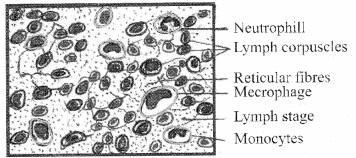
Question 10.
Give an account of elastic cartilage.
Answer :
Elastic cartilage :
- It’s matrix has yellow elastic fibers which are branched.
- It is found in pinna, epiglottis, & tip of nose.
Question 11.
Give an account of calcified cartilage.
Answer :
Calcified Cartilage :
It is a hyalin cartilage which get impregnated with calcium salts.
Question 12.
Give the salient features of epithelial tissue.
Answer :
Term “epithelium” was used by Ruysch. This tissues cover the body organs on the outside & inside. In epithelial tissue, the cells remain closely situated. Hence, due to absence of inter cellular space the inter cellular fluid is absent or very less. They have an inter cellular cementing material which is a glycoprotein containing hyaluronic acid. The epithelial tissues have one or more layers of the cells. The height of the cells is variable such as squamous, flat, cuboidal & columnar.
In epithelial tissues, the cells are based on a basement membrane
Following cellular connections are found in between the cells of the epithelial tissues –
- Tight Junction – They are mainly formed in the cells of columnar epithelium.
- Intercellular bridges – They are mainly found in the transitional epithelium.
- Desmosome or Macula adharence – They are button¬like structures in between the plasma membranes of adjacent cells. They have inter cellular spaces & tonofibrils. They are mainly found in stratified epithelium.
The free (outer) surface of the epithelium may be smooth and it may have microvilli (protoplasmic processes which increase surface for absorption in ileum) or cilia (Example – trachea, oviduct) or stereocilia (Example – epididymis, vas deferens).
Question 13.
Draw a labelled diagram of neuron.
Answer :
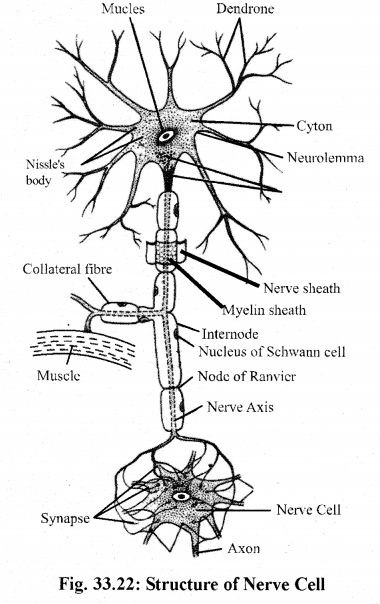
Question 14.
Write the function of muscle tissue.
Answer :
They provide conductibility to body & body parts & facilitate movements & locomotion.
Question 15.
Differentiate striated & unstriated muscles.
Answer :
Striped or Striated Muscles-
They are attached to the bones with the help of tendons/ aponeurosis, hence also called as skeletal muscles. They are voluntary in function, hence also called as voluntary muscles.
The muscle fibre is long, thread-like, unbranched & multinucleated. The muscle fibre, being muscle cell, is bounded by a sarcolemma. It’s cytoplasm is called as sarcoplasm. The muscle fibre consists of myofibrils which are situated parallel to each other. The myofibrils are made up of actin and myosin contractile proteins. The muscle fibre has alternate light and dark bands. The light band is called as I – band (Isotropic band) where dark band is called as A – band (Anisotropic band). There is a Z – line in the centre of I – band. The structure between two Z – lines is called as sarcomere which is a functional unit of muscle. During muscle contraction, the myosin filaments remain stationary while the actin filaments slide over the myosin.
Unstriped or Unstriated Muscles-
They are found in visceral organs such as alimentary canal, blood vessels, trachea, diaphragm, urinary bladder etc. They are also called as involuntary muscles. The muscle cell is spindle shaped, uninucleated & without light & dark bands. The muscle cell has many myofibrils made up of actin & myosin. They contract with rhythm under the control of autonomous nervous system.
RBSE Class 11 Biology Chapter 33 Essay Type Questions
Question 1.
Where the medullated multi polar neurons are found. Give their structure with help of labelled diagram.
Answer :
Types of neurons :
On the basis of number of axon & dendron, the neurons are of three types-
(a) Unipolar neurons – Presence of only one axon. Dendrone is absent. They are found in retina.
(b) Bipolar neurons – Presence of one axon and one dendrone. The}- are found in retina, olfactory epithelium, internal ear etc.
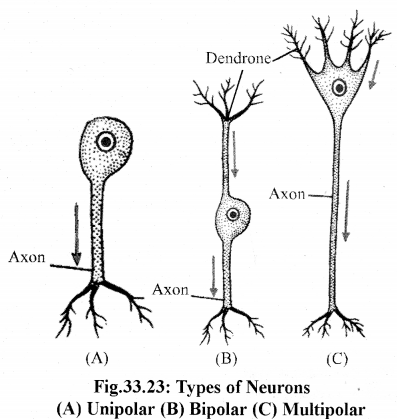
(c) Multipolar neurons – Presence of one axon & two or more dendrones. They are common in brain & spinal cord. The cytoplasm in the c}ton is called as neuroplasm. The neuroplasm consists of special Nissl’s bodies in addition to nucleus & other orgenelles but lacks centrosome.
The axon is covered by whitish & non-cellular myelin sheath which is made up of sphingolipids. There is neurolemma outside the myelin sheath.
The myelin sheath may be absent in some neurons. On the basis of presence/absence of myelin sheath, the neurons are of two typcs-
- Medullated – Presence of myelin sheath around the axon.
- Non – Medullated- Absence of myelin sheath.
The myelin sheath is discontinuous & the gaps are called as nodes of Ranvier. The structure between two nodes is called as internode. The neurolemma of one internode is made up of one Schwann cell. The axon at few places gives out collateral fibres.
The neurons with the help of synapses form nerves. These nerves are of three types-
- Sensory nerves -Transmit nerve impulses from sense organs to the brain.
- Motor nerves- Transmit nerve impulses from brain to the muscles/ glands
- Mixed nerves – Both way transmission of nerve impulses
Question 2.
Explain the blood corpuscles & their functions in mammals.
Answer :
Blood corpuscles :
They form 40 to 45% of the total blood. They are of three types- (i) RBC (ii) WBC (iii) Platelets
- Red blood corpuscles (RBC) or Erythrocytes They are round, disc-like, biconcave and enucleated. They are full of a respiratory’ pigment, the hemoglobin. It is a conjugated protein which is red in color. A molecule of hemoglobin (HB) transports four molecules of Oxygen.

The RBC are formed in red bone marrow and the life of RBC in human beings is 50 to 120 days.
The number of RBC in man is 55 lakh/ mm³ and in woman is 50 lakh/mm³. The amount of hemoglobin is 14 to 16 gm% in man & 12 to 14 gm% in woman. The dead RBC’s are removed from the blood in the liver & they are finally- destroyed in the spleen. Hence, spleen is called as graveyard of RBC. - White blood corpuscles (WBC) or Leucouytes.
They are colorless, nucleated & polymorphic cells. They are larger than RBC. They are formed in red bone marrow lymph nodes & spleen etc. The number of WBC in both man & woman is about 10,000/mm³.
The WBC perform folloyving functions-
(a) They protect the body from diseases by killing the germs directly.
(b) They help to produce immunity by assisting the formation of antibodies.
(c) They help in healing of wounds.
Types of WBC :
(a) Ganulocytes – Their cytoplasm is granular and they are polymorphic. They are three types-
- Neutrophils – They are 65% of the total WBC. Their nucleus is multinlobed. They are stain by neutral dyes such as neural red.
- Eosinophils or Acidophils – They are 2.8% of the total WBC. Their nucleus is bilobed. They are stained by acidic dyes such as Eosin. They control allergy in the body.
- Basophils – They 0.2% of total WBC (least WBC) and stained by basic dyes such as haemotoxylin. They are called as mast cells of the blood. They secrete heparin, histamins & seratonin.
(b) Agranulocytes – Their cytoplasm is without granules & they are two types-
- Monocytes – They are largest WBC and they are 6% of the total WBC. Their nucleus is small & notched. They kill the germs directly. They are also called as big
policeman. - Lymphocytes – They are 26% of the total WBC. Their nucleus is large & round. They are of 2 types viz- B- lymphocyte & T-lymphocyte. They produce antibodies.
- Platelets or Thromocytes
They are formed in red bone marrow from Megakary ocyte. They are irregular in shape & size. They are not complete cells in mammals, hence are not called as thrombocytes in mammals. Their number is about 3 lakh/mm³ and their life is of 2 to 4 days. They contain mainly thromboplastin which participate in blood clotting.
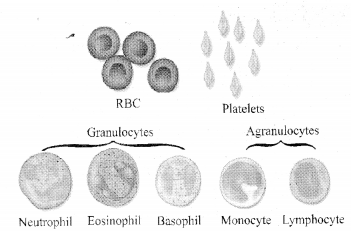
Question 3.
Draw a labelled diagram of T.S. of mammalian bone.
Answer :
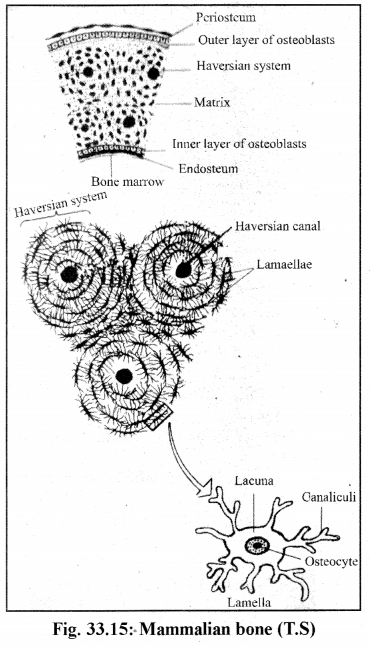
Question 4.
What is sarcomere? Explain the structure of striated muscle with the help of suitable diagram.
Answer :
Striped or Striated Muscles-
They are attached to the bones with the help of tendons/ aponeurosis, hence also called as skeletal muscles. They are voluntary in function, hence also called as voluntary muscles.
The muscle fibre is long, thread-like, unbranched & multinucleated. The muscle fibre, being muscle cell, is bounded by a sarcolemma. It’s cytoplasm is called as sarcoplasm. The muscle fibre consists of myofibrils which are situated parallel to each other. The myofibrils are made up of actin and myosin contractile proteins. The muscle fibre has alternate light and dark bands. The light band is called as I – band (Isotropic band) where dark band is called as A – band (Anisotropic band). There is a Z – line in the centre of I – band. The structure between two Z – lines is called as sarcomere which is a functional unit of muscle. During muscle contraction, the myosin filaments remain stationary while the actin filaments slide over the myosin.
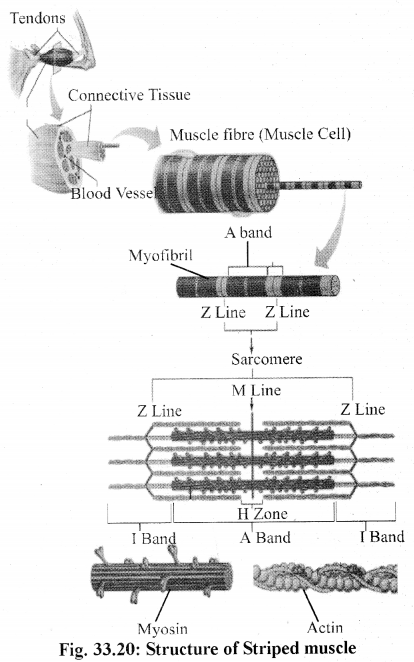
Question 5.
Cartilages are of how many types? Give the structure of hyalin cartilage.
Answer :
Cartilage :
- It contains matrix & chondrioblasts cells.
- The matrix is made up of Chondrin protein & collagen fibres. In some cartilages, the matrix also has elastin fibres & salts.
- The chodrin is a chodro-mucoprotein which provide strength & elasticity to the cartilage.
- The chondrioblasts form chondriocytes & the matrix.
- The chondriocytes remain distributed in the matrix and are enclosed in lacunae.
- Each lacuna encloses one to four chondriocytes.
- The membrane of the lacuna has blood capallaries which supply O2 & food to the chondriocytes.
- The cartilage is bounded by a perichondrium.
- The cartilages are of 4 types-
(i) Hyaline cartilage
- The matrix is clear, semi-transparent & light blue in color.
- It is elastic.
- The matrix is without fibres.
- It is found in hyoid, tracheal rings, larynx and ends of legs bones & ribs.
- It is the hyalin cartilage which has deposition of calcium salts in the matrix.
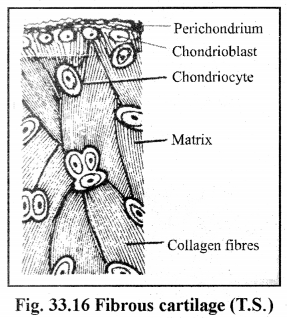
(ii) Elastic cartilage
- It’s matrix has yellow elastic fibres which are branched.
- It is found in pinna, epiglottis, & tip of nose.
(iii) Fibrous cartilage
- It’s matrix has bundles of white collagen fibres. They are unbranched.
- It is a thought cartilage.
- It forms inter vertebral discs & pubic symphoisis of pelvic girdle
(iv) Calcified Cartilage
- It is a hyalin cartilage which get impregnated with calcium salts.
